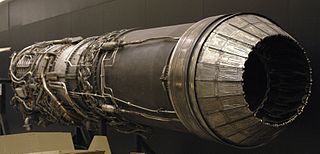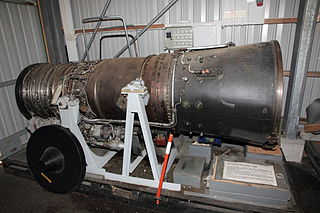
The Pratt & Whitney J57 is an axial-flow turbojet engine developed by Pratt & Whitney in the early 1950s. The J57 was the first 10,000 lbf (45 kN) thrust class engine in the United States. The J57/JT3C was developed into the J52 turbojet, the J75/JT4A turbojet, the JT3D/TF33 turbofan, and the XT57 turboprop. The J57 and JT3C saw extensive use on fighter jets, jetliners, and bombers for many decades.

The Lyulka AL-21 is an axial flow turbojet engine created by the Soviet Design Bureau named for its chief designer Arkhip Lyulka.

The General Electric J79 is an axial-flow turbojet engine built for use in a variety of fighter and bomber aircraft and a supersonic cruise missile. The J79 was produced by General Electric Aircraft Engines in the United States, and under license by several other companies worldwide.

The General Electric/Allison J35 was the United States Air Force's first axial-flow compressor jet engine. Originally developed by General Electric in parallel with the Whittle-based centrifugal-flow J33, the J35 was a fairly simple turbojet, consisting of an eleven-stage axial-flow compressor and a single-stage turbine. With the afterburner, which most models carried, it produced a thrust of 7,400 lbf (33 kN).

The Snecma Atar is a French axial-flow turbojet engine built by Snecma. It was derived from the German World War II BMW 018 design, and developed by ex-BMW engineers through a progression of more powerful models. The name is derived from its original design group, Atelier technique aéronautique de Rickenbach near Lindau within the French Occupation Zone of Germany. The Atar powered many of the French post-war jet aircraft, including the Vautour, Étendard and Super Étendard, Super Mystère and several models of the Mirage.

The General Electric J85 is a small single-shaft turbojet engine. Military versions produce up to 2,950 lbf (13.1 kN) of thrust dry; afterburning variants can reach up to 5,000 lbf (22 kN). The engine, depending upon additional equipment and specific model, weighs from 300 to 500 pounds. It is one of GE's most successful and longest in service military jet engines, with the civilian versions having logged over 16.5 million hours of operation. The United States Air Force plans to continue using the J85 in aircraft through 2040. Civilian models, known as the CJ610, are similar but supplied without an afterburner and are identical to non-afterburning J85 varaints, while the CF700 adds a rear-mounted fan for improved fuel economy.

The SNECMA M53 is an afterburning turbofan engine developed for the Dassault Mirage 2000 fighter by Snecma. The engine is in service with different air forces, including the latest Mirage 2000-5 and 2000-9 multirole fighters.

The Tumansky R-11 was a Soviet Cold War-era turbojet engine.
The Tumansky R-13 is a Soviet turbojet engine designed by Sergei Alekseevich Gavrilov.

The Tumansky R-25 is a turbojet engine, which is seen as the ultimate development of Tumansky R-11. It was designed under the leadership of Sergei Alekseevich Gavrilov.

The Tumansky RD-9 was an early Soviet turbojet engine, not based on pre-existing German or British designs. The AM-5, developed by scaling down the AM-3, was available in 1952 and completed testing in 1953; it produced 25.5 kN (5,700 lbf) thrust without afterburner. AM-5 engine is notable for making the first Soviet supersonic interceptor possible, the MiG-19 and the first all-weather area interceptor, the Yak-25. When Sergei Tumansky replaced Alexander Mikulin as the OKB-24's chief designer in 1956, the engine was renamed RD-9. The engine was later built under license in China as the WP-6.
The Tumansky R-15 is an axial flow, single shaft turbojet with an afterburner. Its best known use is on the Mikoyan-Gurevich MiG-25.

The Saturn AL-31 is a family of military turbofan engines, developed by the Lyulka, now NPO Saturn, in the Soviet Union/Russia, originally for the Sukhoi Su-27 air superiority fighter. It produces a thrust of 28,000 lbf (123 kN) with afterburning in the AL-31F, 31,000 lbf (137 kN) in the AL-31FM (AL-35F) and 33,000 lbf (145 kN) in the AL-37FU variants. Currently it powers all Su-27 derivatives and the Chengdu J-10 multirole jet fighter which has been developed under a Russian license by China.

The Allison J71 was a single spool turbojet engine, designed and built in the United States. It began development in 1948 as a much modified J35, originally designated J35-A-23.

The Sukhoi P-1 was a prototype Soviet interceptor.

The General Electric J73 turbojet was developed by General Electric from the earlier J47 engine. Its original USAF designation was J47-21, but with innovative features including variable inlet guide vanes, double-shell combustor case, and 50% greater airflow was redesignated J73. Its only operational use was in the North American F-86H.
The Lyulka TR-1 was a turbojet designed by Arkhip Lyulka and produced by his Lyulka design bureau. It was the first indigenous Soviet jet engine.
The Lyulka TR-3 was a Soviet axial turbojet designed after World War II by Arkhip Mikhailovich Lyulka.

The Tumansky R-29 is a Soviet turbojet aircraft engine that was developed in the early 1970s. It is generally described as being in the "third generation" of Soviet gas turbine engines which are characterized by high thrust-to-weight ratios and the use of turbine air cooling.
The Tumansky R-21 was a Soviet turbojet engine of the 1960s. Used for development only, the project was canceled.















